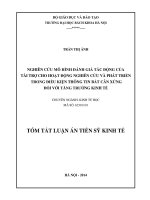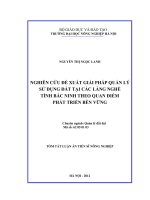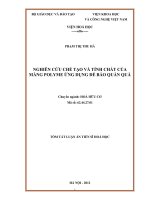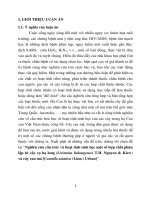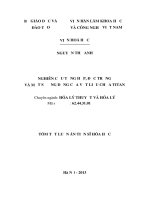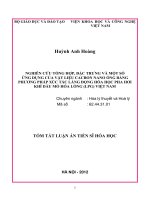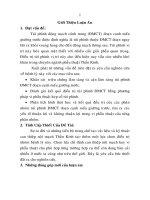Thông tin tóm tắt về những đóng góp mới của luận án tiến sĩ: Nghiên cứu tống hợp và hoạt tính kháng viêm, kháng ung thư các hợp chất lai coxib - combretastatin
Bạn đang xem bản rút gọn của tài liệu. Xem và tải ngay bản đầy đủ của tài liệu tại đây (1.56 MB, 27 trang )
<span class='text_page_counter'>(1)</span><div class='page_container' data-page=1>
<b>AND TRAINING </b> <b>SCIENCE AND TECHNOLOGY </b>
<b>GRADUATE UNIVERSITY OF SCIENCE AND TECHNOLOGY </b>
<b>--- </b>
<b>NGUYEN THI THUY HANG </b>
<b>“SYNTHESIS AND ANTIINFLAMMATORY, ANTIPROLIFERATIVE </b>
<b>ACTIVITIES OF NEW COXIB–COMBRETASTATIN HYBRIDS’’ </b>
<b>Scientific Field: Organic Chemistry </b>
<b>Classification Code: 9.44.01.14 </b>
<b> </b>
<b>DISSERTATION SUMMARY </b>
</div>
<span class='text_page_counter'>(2)</span><div class='page_container' data-page=2>
Vietnam Academy of Science and Technology
Scientific Supervisors:
1. Assoc. Prof. Dr. Ngo Quoc Anh
2. Assoc. Prof. Dr. Vu Dinh Hoang
1st Reviewer: ...
...
2nd Reviewer: ...
...
3rd Reviewer: ...
...
The dissertation will be defended at Graduate University of Science And
Technology, Vietnam Academy of Science and Technology, 18 Hoang Quoc
Viet, Cau Giay District, Ha Noi City.
At ….. hour….. date….. month …..2021.
</div>
<span class='text_page_counter'>(3)</span><div class='page_container' data-page=3>
<b>INSTRODUCTION </b>
<b>1.</b> <b>The urgency of the thesis </b>
Cancer is a group of diseases that involve disorganized cell division and
cells that have the ability to invade other tissues by either growing directly into
nearby tissue or moving to multiple locations different (metastatic). According
to the Global Cancer Organization GLOBOCAN 2018, there are currently
more than 300,000 people living with cancer nationwide, there are 164,671
new cases, 114,871 people die from this disease. Globally, there are about 23
million people infected, of which more than 14 million people are newly
infected and 8 million 2 hundred thousand people die. The World Health
Organization (WHO) ranked Vietnam in the top 50 countries in the top 2 of
the cancer map.
Researching to find cancer treatment drugs with few side effects is one of
the directions that is always interested in the scientific community. Among
current treatments, chemotherapy is a cancer treatment that uses one or more
anticancer drugs - cytotoxic. One of the anti-cancer drugs, used today in
chemotherapy, influences the cell cycle to inhibit cancer cell growth and
subsequently induce apoptosis (apoptosis).
</div>
<span class='text_page_counter'>(4)</span><div class='page_container' data-page=4>
practice, it is still necessary to look for new agents that can overcome the
limitations of resistance and the undesirable side effects of these therapies.
current method [3].
<b>2. Objectives of the dissertation </b>
1. Structured design of coxib - combretastatin hybrid compounds
2. Synthesize coxib - combretastatin hybrid compounds
3. Screening for anti-cancer and anti-inflammatory activities of hybrid
compounds
4. Identifying anti-inflammatory and anti-cancer mechanisms of hybrid
compounds
5. Docking of a hybrid coxib - combretastatin compound with two purpose
effect COX2 and tubulin
<b>3. The main research contents of the thesis </b>
- Research on coxib - combretastatin hybrid compounds synthesis
- Determination of the structure of coxib-combretastatin hybrid compounds
- Screening the activity of coxib - combretastatin hybrid substances
- Study on mechanism of action of some coxib - combretastatin hybrid
substances
</div>
<span class='text_page_counter'>(5)</span><div class='page_container' data-page=5></div>
<span class='text_page_counter'>(6)</span><div class='page_container' data-page=6>
<b>DISSERTATION CONTENTS </b>
<b>CHAPTER 1. LITERATURE REVIEW </b>
General presentation of anticancer compounds by tubulin inhibitory
mechanism, profile of tubulin mechanism. The group of tubulin-based
compounds has always been a topic of concern in the field of anti-cancer drug
research. Combretastatin compounds with rich biological activity have been
used in the treatment of a number of cancers. They are known for their
cytotoxic activity by inhibiting tubulin polymerization at the colchicine site [ 2].
Up to now, these cancer treatment compounds with this mechanism are still
being widely used and always a research direction that receives a lot of
attention.
Overview of combretastatin compounds, which belong to the class of <i>cis</i>
-stilbene, a rich source of pathogens in the search for new drugs, typical
compounds such as resveratrol and combretastatin A-4 phosphate are currently
is clinically tested to treat Alzheimer's disease and cancer. The recently isolated
stilbene has been shown to have a diverse range of biological activities,
including antioxidant, antibacterial, anti-malarial, cytotoxic, liver protective and
anti-inflammatory properties. Combretastatin A-4 (CA4) is also considered to
be a potential cytotoxic agent by strongly inhibiting microtubule polymerization
by binding to the binding point of colchicine on tubulin. CA-4 is highly toxic
on many cancer cell models, making it a very interesting target structure.
</div>
<span class='text_page_counter'>(7)</span><div class='page_container' data-page=7>
substance known for its potent anti-inflammatory activity, which selectively
inhibits COX2 through its action. Prostaglandins induce inflammation and pain
without effects on prostaglandins COX1 that have a protective effect on the
gastrointestinal tract. Furthermore, Celecoxib inhibits the proliferation of
human breast cancer in vitro models such as MCF7 and MDAMB-231. Some
studies indicate that celecoxib and related compounds can induce cell cycle
arrest at G0 /G1 stage leading to apotosis cyclic apoptosis, inhibition of tumor
growth and prevents tumor angiogenesis in the absence of COX2
</div>
<span class='text_page_counter'>(8)</span><div class='page_container' data-page=8>
<b>CHAPTER 2. EXPERIMENTS </b>
<b>2.1. Materials and equipments </b>
<i><b> 2.1.1. Materials </b></i>
<i><b> 2.1.2. Equipments </b></i>
<b>2.2. Methods </b>
<i><b> 2.2.1. Organic synthesis method </b></i>
<i><b> 2.2.3. Biological activity test method </b></i>
<b>2.3. Synthesis of coxib- combrestatin hybrid compounds </b>
<i><b> 2.3.1. Synthesis of ester derivatives of coxib - combretastatin hybrid ester </b></i>
<i><b>hybrid </b></i>
<i><b>Figure 2.2. </b></i>Ester derivative synthesis of coxib - combrestatin hybrids
compound
(<i>i</i>) Alkaline:<i> t</i>-BuOLi (3 mmol, 3 eq), refluxe, (<i>ii</i>) Ethyl chlorooxoacetate (1
mmol, 1 eq) (77), 5 ml THF; (<i>iii</i>) HCl (4 mmol); refluxe, 5 ml C2H5OH dry;
phenylhydrazin (1 mmol, 1 eq) (78).
Synthesized 20 hybrids esters of coxib - combretastatin ester form substances
from 79 to 98.
<i><b>2.3.2. Synthesis of coxib - combrestastatin hybrids compounds containing </b></i>
<i><b>groups CF</b><b>3</b></i>
</div>
<span class='text_page_counter'>(9)</span><div class='page_container' data-page=9>
<i>(a)</i><b> 100 </b>(1.0 mmol), <b>99</b> etyl trifluoroacetate (1,2 eq) and NaH (2,5 eq) in THF (5 mL), 6 h<b>. </b>
<i>(b)</i>, EtOH (5 mL), axit (1.0 eq); arylhydrazin hydrochloride<b> 78 </b> (1.0 mmol) is added
consecutively to the residue and restored for 6 hours. Substance 102 was isolated by column
chromatography.
<i><b> 2.3.3. Synthesis of acid derivatives of coxib - combretastatin hybrid </b></i>
<i><b>Figure 2.8. </b></i>Synthesis of coxib - combretastatin hybrids
(<i>i</i>) Alkaline:<i> t</i>-BuOLi (3 mmol, 3 eq), refluxe, (<i>ii</i>) Ethyl chlorooxoacetate (1
mmol, 1 eq) (77), 5 ml THF; (<i>iii</i>) HCl (4 mmol); refluxe, 5 ml C2H5OH dry;
phenylhydrazin (1 mmol, 1 eq) (78). The product obtained after isolation
through column chromatography was dissolved in the solvent system THF /
MeOH / H2O = 3: 1: 1, then NaH (1,2 eq) was added to the mixture. Carry out
the reaction in 3 hours to obtain compounds acid hybrids 103-122.
successful synthesis of 20 acid hybridization of coxib – combretastatin hybrids
<b>103-122 </b>
<b>2.5. Biologically active testing of research compounds </b>
</div>
<span class='text_page_counter'>(10)</span><div class='page_container' data-page=10>
<b>CHAPTER 3. RESULTS AND DISCUSSIONS</b>
The advantages of using a hybrid molecule over co-combination of multiple
drugs at the same time may improve the limitations of adverse effects and
resistance [107]. Despite its outstanding activity, combretastatin still has many
undesirable effects. This is why the team aims to combine combretastatin, an
anticancer compound, and celecoxib, a COX2-engineered anti-inflammatory
agent, as derivatives for new hybrid compounds in hopes of finding new It has
interesting biologically active properties such as the anticancer and
anti-inflammatory properties of the parent substance and has less side effects.
<b>3.1. Design of the structure and biological activity of the hybrids </b>
<i><b>3.1.1. Design of hybrid molecular structure</b></i>
</div>
<span class='text_page_counter'>(11)</span><div class='page_container' data-page=11>
<i><b>Figure 3.1.</b></i> C Structure of celecoxib, combretastatin A4 and the coxib–
combretastatin hybrids
<i><b>3.1.2. Design of hybrid molecular biology activities</b></i>
</div>
<span class='text_page_counter'>(12)</span><div class='page_container' data-page=12>
multi-target drug by combining COX-2-selective inhibition with nitric oxide
(NO)-dependent activities has been initiated [112-114].
In infammation, the activated immune cells such as macrophages secrete
everal infammatory mediators such as proinfammatory cytokines, nitric oxide
(NO) and prostaglandin E2 (PGE2). In our previous study, tested compounds
and celecoxib were examined for their efects on nitric oxide (NO) production in
LPS-activated murine macrophage RAW 264.7 cells 264.7 cells [115].
Prostaglandin E2 is present in high concentrations in breast tumors and in
metastatic cancers, in the absence of estrogen and progesterone receptors
[116-117]. Hence, the ability to inhibit production of PGE2 can be considered a good
strategy in the design of anticancer agents. However, the MCF7 breast cancer
cells produced very low levels of PGE2, according to another report [109].
Therefore, the active efficacy of the hybrid compounds was tested for the
inflammatory response induced by LPS instead of by inhibiting PGE2 on
MCF7 [118]..
Therefore, cancer cell lines HT-29, Hep-G2, MCF-7 and inhibition of NO
production were selected as initial tools to screen for anti-inflammatory activity
of the study agent class. And to determine the inflammatory and
anti-cancer mechanisms of the hybrid substances, studies of PGE2 production
inhibition activity, cell cycle analysis methods, apoptosis methods by nuclear
staining. cells with Hoechst 33342, study of apotosis-inducing activity by
caspase-3 indicator, study of apoptosis induction by FITC-anexin V and PI
stained cell photometric method. Finally, substances selected and studied on
biological mechanisms will be tested to interact with tubulin and COX2 targets
by molecular docking method to confirm the biologic accuracy of the model <i>in </i>
<i>vitro</i>.
<b>3.2. Synthesis of coxib - combretastatin hybrids </b>
</div>
<span class='text_page_counter'>(13)</span><div class='page_container' data-page=13>
oxalyl chloride arylhydrazine hydrochloride derivatives (Figure 2.1 , Figure 2.2,
Figure 2.7, Figure 2.8) [109]. Reaction of Claisen condensation between two
components 1,2-diarylethanon and ethyl oxalyl chloride with alkaline agent
using tert-BuOLi, obtained the lithium salt intermediate product of ethyl
2,4-dioxo-3,4-diarylbutanoate , the reaction is continued with arylhydrazine
hydrochloride through the Knorr reaction catalyzed by hydrochloric acid to
produce triarylpyrazole-3-carboxylate (hybrids compound <b>79 to </b> <b>98) and </b>
(hybrids compound <b>103 to 122). A cycle of celecoxib derivatization was also </b>
applied (Figure 2.4, Figure 2.5) 3,4,5-trimethoxyphenyl -
1,1,1-trifluoro-2,4-butanedion (65, 102) obtained from Claisen condensation between
acetophenone and ethyl trifluoroacetate derivatives then reacts with
4-sulfamidophenyl hydrazine halide salt to form 3,4,5-trimethoxyphenyl, a
substance with structure similar to celecoxib.
According to the reaction procedures described in Figure 2.1, Figure 2.2,
20 coxib-combretastatin hybrid compounds were successfully synthesized with
efficiency from 64 to 83% (Table 3.1) 02 compounds containing CF3 group
with difference rates are 95% respectively. 78% (table 3.2). 20 acidic
compounds of coxib - combretastatin hybrid with efficiency from 54 - 74%
(Table 3.3); The substances are structurally determined by the methods of
purification and nuclear magnetic resonance spectroscopy method NMR 1D,
2D.
Of the hybrid compounds obtained, substances <b>79 to 98 and 102 to 122 </b>
were synthesized for the first time and never previously published. And 01
compound has been published and also used as a comparator is celecoxib (65)
which is known for many studies [78-79].
</div>
<span class='text_page_counter'>(14)</span><div class='page_container' data-page=14>
<i><b>3.3.1. Screening for biological activity of coxib - combretastatin hybrids </b></i>
<b>Screening activity of 20 ester-based coxib-combretastatin hybrid </b>
<b>compounds and 02 hybrid compounds containing groups CF3 </b>
</div>
<span class='text_page_counter'>(15)</span><div class='page_container' data-page=15>
inhibitory activity, emphasizing that they may have a better safety in the
cardiovascular system than celecoxib [110].
<i><b>Table 3.4. </b></i>The cytotoxic effect of ester-type hybrid compounds on three cancer
cell lines HT-29, Hep-G2, MCF7 and inhibition of NO production
<b>Entry </b> <b>Comp. R </b> <b>R’ </b> <b>R’’ </b> <b>IC50 (µM) </b>
<b>Inhibits </b> <b>NO </b>
<b>production </b>
<b>HT-29 </b> <b>Hep-G2 </b> <b>MCF-7 </b>
<b>1 </b> <b>102 </b>
3,4,5-triOMe
4-NH2SO2 <b>1.95±0.11 </b> 43.0 ± 6.0 39.96± 3.36 <b>4.63± 0.59 </b>
<b>2 </b> <b>96 </b> H 4-F 4-NH2SO2 81.6 ± 10.6 18.7 ± 1.7 29.37± 1.90 <b>7.97±0.51 </b>
<b>3 </b> <b>81 </b> H H 4-CN 116.83±7.7 37.6±3.5 >254 <b>8.20± 0.93 </b>
<b>4 </b> <b>82 </b> H H 4-NO2 129.88±15.7 21.2±2.1 >242 <b>9.67± 0.92 </b>
<b>5 </b> <b>94 </b> H 4-OH 4-NH2SO2 92.3 ± 7.2 18.8 ± 1.5 <b>14.51±1.36 </b> <b>8.90± 0.79 </b>
<b>6 </b> <b>93 </b> H 4-Br 4-NH2SO2 73.7 ± 2.6 23.5 ± 1.8 35.48±2.85 19.27±0.27
<b>7 </b> <b>91 </b> H 4-Br 4-CN 116.01±13.6 32.6± 3.0 >211 20.16± 1.83
<b>8 </b> <b>92 </b> H 4-Br 4-NO2 91.58±7.8 153.2± 10 >203 21.30± 1.40
<b>9 </b> <b>89 </b> H 4-Br 4-OMe 21.01±4.3 39.6±2.9 >209 21.51± 1.48
<b>10 </b> <b>90 </b> H 4-Br 4-CF3 > 233 <b>10.0±0.7 </b> 75.87±4.41 21.65± 1.86
<b>11 </b> <b>97 </b> H 4-Cl 4-NH2SO2 122.2 ± 9.7 14.1 ± 1 37.04±4.95 23.79± 3.11
<b>12 </b> <b>85 </b>
4-OMe
4-OMe 4-CF3 134.10±15.7 107± 10 >201 29.80± 2.71
<b>13 </b> <b>43 </b> <b>4-Me </b> <b>4-NH2SO2 </b> <b>83.59 ± 5.0 </b> <b>58.4 ± 3.4 </b> <b>37.11±2.14 </b> <b>30.67±3.79 </b>
<b>14 </b> <b>98 </b> H 4,6-
diOMe
4-NH2SO2 <b>4.41±0.17 </b> 136.0 ± 12 >197 39.93± 2.64
</div>
<span class='text_page_counter'>(16)</span><div class='page_container' data-page=16>
<i><b>Table 3.5. </b></i>Comparison of cytotoxic effects of acid and ester hybrid compounds
on MCF-7 cancer cells and inhibition of NO production
<b>16 </b> <b>79 </b> H H 4-OMe 30.0±13.4 >251 21.43±1.93 43.19±4.86
<b>17 </b> <b>87 </b>
4-OMe
4-OMe 4-NO2 148.85±8.4 >211 >211 48.81± 2.62
<b>18 </b> <b>86 </b>
4-OMe
4-OMe 4-CN 76.42±9.4 110.3±7.0 >220 48.86± 3.13
<b>19 </b> <b>84 </b>
4-OMe
4-OMe 4-OMe 67.06±3.7 160±15 >218 49.32± 1.72
<b>20 </b> <b>80 </b> H H 4-CF3 59.52±5.5 17.3±2.0 63.17± 3.01 50.66± 4.46
<b>21 </b> <b>88 </b>
4-OMe
4-OMe 4-NH2SO2 103.4 ±10.5 99.0±6.3 58.57± 4.70 68.43± 7.05
<b>22 </b> <b>98 </b> H 4,6-diOH 4-NH2SO2 > 208.5 173.9 ± 12 64.03± 5.75 83.60± 3.44
<b>L-NMMA</b> 8.39±0.31
<b>Ellipticine</b> 0.18± 0.04 0.44± 0.05 0.36± 0.04
<b>STT </b> <b>R </b> <b>R’ </b> <b>R’’ </b>
<b>IC50 (µM) </b>
<b>Este (NO) </b> <b>Acid (NO) </b> <b>Este </b>
<b>(MCF-7) </b>
<b>Acid (MCF7) </b>
<b>1 </b> 3,4,5-triOMe 4-NH2SO2 <b>1.95±0.11 </b> 43.0 ± 6.0 39.96± 3.36 <b>4.63± 0.59 </b>
<b>2 </b> H 4-F 4-NH2SO2 81.6 ± 10.6 194.5±7.6 <b>7.97±0.51 </b> 187.7±9.5
<b>3 </b> H H 4-CN 116.83±7.7 256.7±22.1 <b>8.20± 0.93 </b> 154.5±15.1
<b>4 </b> H H 4-NO2 129.88±15.7 >261.1 <b>9.67± 0.92 </b> 187.6±10.4
<b>5 </b> H 4-OH 4-NH2SO2 92.3 ± 7.2 75.8±2.6 <b>8.90± 0.79 </b> 34.6±2.6
<b>6 </b> H 4-Br 4-NH2SO2 73.7 ± 2.6 >202.0 19.27±0.27 149.5±7.3
</div>
<span class='text_page_counter'>(17)</span><div class='page_container' data-page=17>
<i>Note: *: Statistics column of ester activity </i>
<i> **: Statistics column of acidic activity </i>
The super-active hybrid compounds <b>102, 96, 81, 82, 94 and celecoxib </b>
continued to be transferred to the PGE2 production test to further screen for the
anti-inflammatory and anticancer activities of the active ingredient.
<i><b>3.3.2. Study on anti-inflammatory and anti-cancer mechanisms </b></i>
<b>8 </b> H 4-Br 4-NO2 91.58±7.8 111.2±8.7 21.30± 1.40 <b>34.0±6.4 </b>
<b>9 </b> H 4-Br 4-OMe 21.01±4.3 >223.7 21.51± 1.48 >223.7
<b>10 </b> H 4-Br 4-CF3 > 233 80.0±6.3 21.65± 1.86 129.5±9.7
<b>11 </b> H 4-Cl 4-NH2SO2 122.2 ± 9.7 >220.7 23.79± 3.11 191.1±20.6
<b>12 </b> 4-OMe 4-OMe 4-CF3 134.10±15.7 140.3±16.7 29.80± 2.71 136.0±8.4
<b>13 </b> 4-Me 4-NH2SO2 <b>83.59 ± 5.0 </b> <b>30.67±3.79 </b> <b>30.0±3.3 </b>
<b>14 </b> H 4,6- diOMe 4-NH2SO2 <b>4.41±0.17 </b> >208.7 39.93± 2.64 94.0±6.4
<b>15 </b> H H 4-NH2SO2 > 233 >239.8 40.54±2.56 178.9±12.9
<b>16 </b> H H 4-OMe 30.0±13.4 >271.7 43.19±4.86 209.3 ± 20.0
<b>17 </b> 4-OMe 4-OMe 4-NO2 148.85±8.4 185.9±9.8 48.81± 2.62 <b>31.8±3.7 </b>
<b>18 </b> 4-OMe 4-OMe 4-CN 76.42±9.4 157.0±12.2 48.86± 3.13 83.0±10.3
<b>19 </b> 4-OMe 4-OMe 4-OMe 67.06±3.7 145.7±15.2 49.32± 1.72 75.7±6.9
<b>20 </b> H H 4-CF3 59.52±5.5 109.4±5.8 50.66± 4.46 203.8 ± 5.1
<b>21 </b> 4-OMe 4-OMe 4-NH2SO2 103.4 ±10.5 >209 68.43± 7.05 150.0±14.7
<b>22 </b> H 4,6-diOH 4-NH2SO2 > 208.5 >222.0 83.60± 3.44 >222.0
<b>L-NMMA</b> 8.39±0.31
</div>
<span class='text_page_counter'>(18)</span><div class='page_container' data-page=18>
<i> 3.3.2.1. Study on PGE2 production inhibition activity </i>
Typical compounds 102, 96, 81, 82, 94, celecoxib continued to be tested for the
ability to inhibit PGE2 production.
<i><b>Table 3.7. </b></i>Effect of test compounds on PEG2 production in LPS-stimulated
RAW 264.7 macrophages
<b>PGE2 (pg/ml) </b>
<b>Concentration </b>
<b>(µM) </b> <b>102 </b> <b>96 </b> <b>81 </b> <b>82 </b> <b>94 </b>
<b>Concentration </b>
<b>(µM) </b> <b>Celecoxib (43) </b>
20 65.31 223.82 253.60 155.07 246.88 100 41.45
4 133.59 326.20 277.23 383.49 488.82 20 129.83
0.8 225.56 399.56 490.73 478.52 560.34 4 278.64
LPS 329.60
<i><b> </b>3.3.2.2. Cell cycle analysis</i>
Compounds 96, 81, 82 and <b>94 increased the number of cells in G0/G1 phase and </b>
decreased them in S and G2/M phases as celecoxib did. Celecoxib and related compounds
ere also known to be able to inhibit
tumor growth and to induce apoptosis Some research also resulted in the stable G0 /G1
block efect of celecoxib with unclear involvement of COX-2 as well as of PGE2 [104]. On
other hand, compound 102 caused G2/M phase arrest as evidenced by the increase in cell
number with a concomitant decrease in cells in phase S. G2/M phase arrest prevents cells
from exiting mitosis, a feature shared by microtubule inhibiting agents such as colchicine or
combretastatins [78]. In case of compound <b>102, replacement of the double bond of CA4 </b>
with pyrazole ring of celecoxib and maintaining trimethoxybenzene moiety of CA-4 were
demonstrated to be crucial to obtain relevant cytotoxic and antimitotic efects [98, 115].
<i><b>Table 3.8. </b></i>Percentage of cell by phases of tested compounds in MCF7cells entrie
<b>Entries Compound </b> <b>Percentage of cell by phases (%) </b>
<b>% G0/G1 </b> <b>% S </b> <b>% G2/M </b>
1 Negative control
(DMSO 0,5%) 42.46 40.47 13.15
2 <b>102</b> (10 µM) 40.72 35.09 21.04
3 <b>96</b> (10 µM) 49.00 34.17 14.17
4 <b>81 </b>(10 µM) 45.22 34.46 17.45
5 <b>82 </b>(10 µM) 50.96 30.75 14.80
6 <b>94</b> (10 µM) 49.55 34.50 14.34
</div>
<span class='text_page_counter'>(19)</span><div class='page_container' data-page=19>
<b>(-) control </b> <b>102 </b> <b>96 </b>
<b>81 </b> <b>82 </b> <b>94 </b>
<b>Celecoxib (43) </b>
<i><b>Figure 3.3</b></i><b>. Cell cycle analysis of tested compounds including 102, 96, 81, 82, </b>
<b>94 and celecoxib at the concentration of 10 µM on MCF-7 human breast cancer </b>
cells using Novocyte fow cytometry system (the experiment has been done one
time)
<i> 3.3.2.3. Research results of apoptosis-causing activity of compounds <b>82 </b>and </i>
<i><b>102</b></i>
Since compounds <b>102 and 82 are potential inhibitors of antiproliferative </b>
activity, inhibiting PGE2 production more potent than celecoxib and selectively
inhibiting cell cycle, it was selected for further evaluation of potential for
apoptosis.
</div>
<span class='text_page_counter'>(20)</span><div class='page_container' data-page=20>
<i><b>Table 3. 9.</b></i> Percent of condensation or fragmentation in the cell nucleus caused
by compounds 102 and 82
<b>Tế bào Apoptosis (%) </b>
<b>82 </b>
(20 µM)
<b>82 </b>
(10 µM)
<b>82 </b>
(5 µM)
<b>102 </b>
(20 µM)
<b>102 </b>
(10 µM)
<b>102 </b>
(5 µM)
<b>Camptotheci</b>
<b>n </b>
(5µM)
<b>(-) </b>
<b>Control </b>
5.33 ± 0.34 2.69± 0.22
2.42±
0.27 12.38± 0.96
5.18±
0.33
3.55±
0.39 22.71± 2.01
2.71±
0.29
The study samples obtained MCF7 cell image after being stained with Hoechst
33342 at different concentrations:
Negative control Camptothecin (5
µM)
<b>102 (20 µM) </b>
<b>102 (10 µM) </b> <b>82 (20 µM) </b> <b>82 (10 µM) </b>
<i><b>Figure 3.4.</b></i> Image of MCF7 cells under the influence of research samples
stained with Hoechst 33342 at different concentrations
<b>Study of apotosis-inducing activity by caspase-3 indicator </b>
<i><b>Table 3.10.</b></i> Activation of caspase 3 by compounds 102 and 82
<b>% Tế bào Apoptosis </b>
<b>Comp. </b> <b>102 </b>
<b>(20 µM) </b>
<b>102 (10 </b>
<b>µM) </b>
<b>102 </b>
<b>(5 µM) </b>
<b>82 </b>
<b>(20µM) </b>
<b>82 </b>
<b>(10 µM) </b>
<b>82 </b>
<b>(5 µM) </b>
<b>Camptothecin </b>
<b>(5µM) </b>
<b>(-) </b>
<b>control </b>
Mean 1.36* 1.21* 1.01 1.08 1.12 1.11 1.67** 1.00
(SD) 0.033 0.013 0.037 0.023 0.056 0.040 0.020 0.070
</div>
<span class='text_page_counter'>(21)</span><div class='page_container' data-page=21>
<b>Study on apoptosis induction by FITC-anexin V and PI stained cell photometric </b>
<b>method </b>
<i><b>Table 3.11.</b></i> Percentage of apoptosis cells
Samples % Necrotic
cells
% Early
apoptosis cell
% % late
apoptosis cell
%
Apoptosis
cells
Negative control 0.22 18.32 1.90 20.22
<b>82 </b>(20 µM) 1.39 18.49 4.08 22.57
<b>82 </b> (10 µM) 0.27 21.62 4.59 26.21
<b>82</b> (5 µM) 0.16 22.74 3.27 26.01
<b>102</b> (20 µM) 0.42 42.24 6.73 48.97*
<b>102 </b>(10 µM) 0.49 19.90 3.45 23.35
<b>102</b> (5 µM) 0.27 15.84 2.17 18.01
Camptothecin (5µM) 0.08 73.83 4.96 78.79**
Ghi chú: * là P<0.05; ** là P<0.01
Cell incubated with
compound 82 (20 µg/ml)
in 48h
Cell incubated with
compound <b>82 </b> (10
µg/ml) in 48h
Cell incubated with
compound <b>82 </b> (5
µg/ml) in 48h
Cell incubated with
compound <b>102 </b> (20
µg/ml) in 48h
Cell incubated with
compound <b>102 (10 </b>
µg/ml) in 48h
</div>
<span class='text_page_counter'>(22)</span><div class='page_container' data-page=22>
Cell incubated with
0.5% DMSO trong 48h
Cell incubated with5
µM camptothecin in
48 h
<i><b>Fig 3.5.</b></i> Cell apoptosis of tested compounds via Dead Cell Apoptosis Kit
with Annexin V FITC and PI for fowcytometry. The x-axis represents the
level of FITC-Annexin V staining; the y-axis represents the level of PI
staining in log units.
<i><b>The conclusions determine the apoptosis induction potential of two study </b></i>
<i><b>samples </b></i>
Through the determination of apoptosis induction through three methods of
detecting apoptosis of the active substance by staining the cell nucleus with
Hoechst 33342, caspase - 3 and cytometry can be summarized:
Sample 82 at test concentrations slightly increased the proportion of cells
in early apoptosis and late apoptosis compared with negative control,
reaching 22.57-26.21%.
Sample <b>102, at a concentration of 20 µg / ml increased the incidence of </b>
early and late apoptosis cells from 18.3% to 42.2% and 1.90% to 6.7% in
the negative control, respectively. At lower concentrations there was a
slight increase (10 µg / ml and 5 /g / ml) in the incidence of apoptosis
compared to the negative control.
Camptothecin - positive control increased apoptosis rate, reaching from
78.79%.
Sample <b>82 has not clearly shown the ability to induce apoptosis to </b>
research concentrations in the trials performed;
</div>
<span class='text_page_counter'>(23)</span><div class='page_container' data-page=23>
Sample <b>102 at a concentration of 20 M induces apoptosis on MCF7 cells </b>
through: inducing concentration or fragmentation of the cell nucleus at a
rate of 12,386%; induction of caspase -3 generation with concentration
increased 1.36 times compared with negative control (P <0.01); Apoptosis
increased and especially early apoptosis increased 42.24% through cell
photometric technique (P <0.05).
Thereby, based on the results of cytotoxic activity, NO, PGE2
anti-inflammatory and apoptosis induction, we confirmed the mechanism and
activity characteristics of the obtained hybrid compounds. The results showed
that the hybrid molecule in terms of both molecular structure and biological
activity according to the design target model of the original hybrid molecule.
We have continued to opt for molecular docking analysis to simulate the
interaction between engineered hybrid with COX2 and tubulin targets.
<i><b>4. Molecular docking study </b></i>
According to AutoDock's rating criteria 4.2.6, the negative the value of
energy, the better the ability of the compound to bind to the targeted receptor.
Compounds <b>102 and 82 were shown to be two potential candidates with good </b>
binding energies for both targets and can be considered as potential COX2 /
tubulin dual inhibitors, their interactions analyzed. added using Model Studio
Visualizer. The resulting computation can be used to better predict a protein
mode inhi itor ased on the differen e Δ etween the COX2 intera tion
value and tubulin (Equation 1–2).
ΔG=Do k s oreCOX2−Dockscroretubulin (1)
ΔLE=LECOX2−Letubulin (2)
Dock pose of compound <b>102 in the active site of COX2 showed three </b>
hydrogen bonds interaction between the sulfonamide group (SO2NH2) and
</div>
<span class='text_page_counter'>(24)</span><div class='page_container' data-page=24>
residues Arg106 of COX2 and Ala250 of tubulin (distance = 2.99; 3.18 Å,
respectively); particularly, the NO2 group of 6cwas observed to interact only
with residue Phe504 of COX2. This fnding supports our assumption that the
sulfonamide and ethyl ester groups play an important role for the dual activities
of compounds 102 and <b>82. On the other hand, the trimethoxybenzene and other </b>
aryl substituents are assumed to characterize the specifc binding of each
compound to protein targets.
<i><b>Table 3.12.</b></i> Set of designed compounds with respective docking score on
COX2 and tubulin model.
<b>Designed compounds </b> <b>Dock score (kcal/mol) </b>
<b>COX2 (3LN1) </b> <b>Tubulin (1Z2B) </b>
<b>102 </b> -11.90 -8.06
<b>82 </b> -11.92 -9.37
<b>Combretastatin A4 </b> -9.63 -7.75
<b>Colchicin </b> - -8.06
<b>Celecoxib </b> -11.50 -
Docking 82 -Cox2
Docking 82 – tubulin
Docking 102 - COX2 <sub>Docking 102 -tubulin </sub>
</div>
<span class='text_page_counter'>(25)</span><div class='page_container' data-page=25>
Designed compounds
Ligand efciency (LE)
COX2 Tubulin ΔLE
<b>102 </b> - 0.38 - 0.26 -0.12
<b>82 </b> - 0.38 - 0.30 -0.08
Combretatin A4 - 0.42 - 0.34 -0.08
Colchicin - - 0.28 -
Celecoxib - 0.44 - -
<b>CONCLUSION </b>
<b>The thesis has achieved the following main results: </b>
1. Successful design and synthesis of 41 multi target coxib - combretastatin
hybrids. In which, there are 20 coxib - combretastatin ester hybrid compounds,
20 acid coxib - combretastatin hybrid compounds, 01 coxib - combretastatin
hybrid compound contains CF3 group.
2. Evaluated biological activity of 22 substances on human cancer cell lines
HT-29, Hep-G2, MCF-7 and inhibited NO production. In which 12 substances
<b>102, </b> <b>96, </b> <b>81, </b> <b>82, </b> <b>94, </b> <b>93, </b> <b>91, </b> <b>92, </b> <b>89, </b> <b>90, </b> <b>97, 85 show outstanding activity </b>
compared with celecoxib radicals, 05 substances <b>102, 96, 81, 82, 94 has IC50 </b>
activity <10 µM
3. Evaluation of NO production inhibition and breast cancer MCF-7 activity
against acid-based coxib - combretastatin hybrids and comparison of
ester-based coxib - combretastatin hybrids. However, the results showed that only 02
substances <b>118 and 114 exhibited cytotoxicity on the lines of MCF-7 stronger </b>
than celecoxib and 02 substances <b>116 and 111 are equivalent to inhibiting NO </b>
production of celecoxib.
</div>
<span class='text_page_counter'>(26)</span><div class='page_container' data-page=26>
5.Collected 2 typical of compouds <b>82 and </b> <b>102, which are bio-multi-target </b>
molecules, have outstanding activity in anticancer activity compared with
combretastatin and anti-inflammatory compared to celecoxib.
6. On the molecular docking model, it is confirmed that two compouds 82 and
<b>102 show double activity with two purposes of tubulin and COX2 effects </b>
according to the design objectives of the thesis.
7. The substances obtained were shown to be non-toxic to normal cells in an in
vitro model.
Request:. Further research into the anticancer and anti-inflammatory activity of
these hybrid compounds has been obtained and clinical trials for the
introduction of new anti-cancer drugs.
<b>NEW CONTRIBUTIONS OF THE DISSERTATION </b>
1. Successful design and synthesis of 41 multi target coxib - combretastatin
hybrids.
2. Screening anti-inflammatory and anti-proliferative activity of the news
hybrids.
3. Evaluating of biological mechanism of the hybrid compounds in vitro
4. Determinning interaction affinity of the hybrid on tubulin and COX2 by
</div>
<span class='text_page_counter'>(27)</span><div class='page_container' data-page=27>
<b>PUBLICATIONS </b>
1. Thuy Hang Nguyen Thi, Yen Tran Thi, Le Anh Nguyen, Ngoc Binh Vo,
Quo Anh Ngo. “<i>Design, Synthesis and Biological Activities of New Pyrazole </i>
<i>Derivatives Possessing Both Coxib and Combretastatins Pharmacophores</i>”.
Chem. Biodiversity, 2019.
2. Quoc Anh Ngo, Thuy Hang Nguyen Thi, Minh Quan Pham, Domenico
De fno hi hao Do. “<i>Antiproliferative and antiinfammatory coxib–</i>
<i>combretastatin hybrids suppress cell cycle progression and induce apoptosis of </i>
<i>MCF7 breast cancer cells</i>” o e u ar Diversity 2020.
3. Nguyen Thi Thuy Hang, Nguyen Le Anh, Tran hị Yen, Vo Ngọ Binh, Vu
Đinh Hoang, Ngo Quoc Anh. “<i>Synthesis study of hybrid derivatives between </i>
<i>combretastatin and celecoxib</i>”. <i>Vietnam Journal of Chemistry</i>, 2017, 55(4E23),
235-239.
</div>
<!--links-->
Thông tin tóm tắt về những kết mới của luận án tiến sĩ
- 1
- 582
- 0
